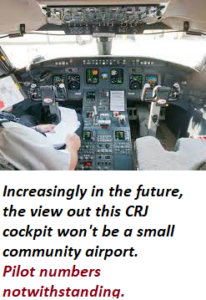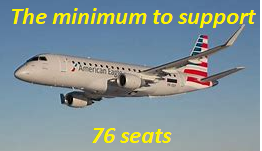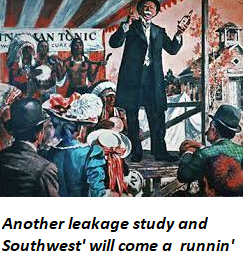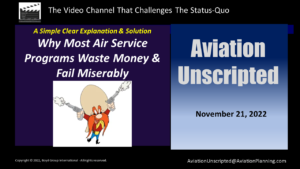Year 2023: Air Service Planning: Reality Settles In
Reality One: Airline Re-Fleeting – No, There Is No Pilot Rescue For Small Communities
Let’s start with this. It is most unfortunate that the Regional Airline Association is so much off-base. Their recent report on the small airport service “crisis” is based on narratives that are galaxies removed from the real world of the 21st century.
 Their message is that small airports have lost service over the past few years entirely due to lack of pilots. Goodness, congress! Take action now! Otherwise, small communities will die on the economic vine! That sounds great. But it’s not consistent with the economic world the rest of us live in. It is in fact misleading.
Their message is that small airports have lost service over the past few years entirely due to lack of pilots. Goodness, congress! Take action now! Otherwise, small communities will die on the economic vine! That sounds great. But it’s not consistent with the economic world the rest of us live in. It is in fact misleading.
RAA would have us to believe that all small communities need to have scheduled flights at the local airport, or the town’s future will eventually resemble Dresden after the bombers left. They would also have us believe that such service is economically possible. Both narratives are in the wrong direction and send small community planning there, too.
In most cases, it’s the shift in economics – the revenue v the cost – of operating small community service that’s torpedoed a lot of service at local airports.
This is not a “crisis” as the RAA describes it. It is reality.
Reality Two: The Consumer Has Better Options. Many Local Ones Are Economically Unsupportable.
In reality, it’s often the consumers that are the core reason. that local service dies. They are finding that the hour or even 90-minute drive to a larger airport is more total travel time-efficient than trying to use the two or three hub connect flights that the local airport can barely support. That ”true market study” or “catchment analysis” or whatever set of heatmap-infested reports can be concocted won’t change this.
The air transportation system and its economic underpinnings have moved on.
The result of what the RAA is putting out is a lot of false hope and encouraging a lot of wasted money at small communities being spent on quack studies to attract airline service that doesn’t exist or won’t work. Gee, the RAA says it. No need to check it out, right?
There’s recently been some pap that American is expanding use of 50-seat jets. Don’t buy it as a trend. They’re just applying the aircraft they are newly leasing in from Air Wisconsin, and which were previously flying as part of United.
The hard fact is that economics – and not pilot shortages –are driving 50-seaters into the desert.
Reality Three: Small Jets – What Goes To The Desert, Stays In The Desert. Room For More.
There is also the oft-repeated factoid that American has 150 of its small jet fleet parked. The implication is that when more pilots come into the picture, these airplanes will be back in the skies.
Not likely.
This isn’t going to be a capacity cavalry coming over the small community hill. As far as the data can be determined, only a couple of these are larger CRJ700 and CRJ900 units. All the rest are either 50-seaters, or 37-seat ERJs. Chances of these coming back are right up there with Elvis being the first booking.
Reality Four: The Future Is Larger “Small” Airliners, And There Aren’t A Lot In The Pipeline.
 The only new replacements for the exiting 50-seaters are Embraer E175s, and they represent whole different operating economics.
The only new replacements for the exiting 50-seaters are Embraer E175s, and they represent whole different operating economics.
That means they can’t and won’t be one-for-one replacements. There are lots of E175s “on option” but very few actually on hard order at US operators at this time.
Most available CRJ700s are already in the sky. Same with CRJ900s. They are off the market. The E175 is the only scope-compatible small airliner in production. Plus, there are none under development.
Do the math. It doesn’t indicate that just adding more pilots will reverse the hard dynamics that are affecting local small community air service.
Reality Five: In 2023, It’s Okay To Shoot The Messenger If He’s Peddling Garbage.
Point: the economic bar for small community air service is going up. And importantly, there’re no longer any mysteries in regard to  the viable air service options available to every airport in the nation. Or, in some cases, the clear lack of such options.
the viable air service options available to every airport in the nation. Or, in some cases, the clear lack of such options.
The need for hard, direct analysis of the true options, instead of jive programs that focus on vague objectives to “get more airlines” instead of specific community air access needs will be front and center.
Prediction: In 2023, fewer and fewer airports and communities will be available to be hornswoggled by massive consultant programs to find airline service that doesn’t exist.
Reality Six: Identifying The Need, Determining Potential For Success, And Then Targeting.
Air service development must concentrate on the specific air access needs of the region, and on a clear understanding of what the options are for attaining them.
The traditional scattershot programs won’t work anymore. Going to speed date meetings and spending a pleasant 20 minutes with Southwest is nice. But as far as gaining service at a small rural community, it’s a functional waste of everybody’s time.
It’s access that counts. Going after airlines for the sake of having an airline won’t do much except waste money. The need is to facilitate business. Communities that focus on real-world economic solutions – which in some cases means regionalized access – are dealing with the future.
Then there is the ULCC impulse option. It is not access, but simply a new spend option. For a lot of points, the traditional ULCC leisure model can work because it naturally attracts traffic from a wide geographic area. The challenge for the immediate future is the continued high levels of discretionary dollars in the face of 8% – 10% (or higher) inflation. Also, as noted in our last Monday Update, this sector may be shifting toward more core market flying, in direct competition with network carriers.
Reality Seven: Get Clear & Focused. Don’t Hunt Unless You Know What You’re Hunting
 We’d suggest investing 12 minutes and take a look at our latest Aviation Unscripted video.
We’d suggest investing 12 minutes and take a look at our latest Aviation Unscripted video.
No holds barred, and straight talk. It has points that are completely missed in most traditional air service development programs. It will cross some lines that need to be crossed.
And while you’re there, hit the subscribe button and join us.
Click here or on the icon to join us.